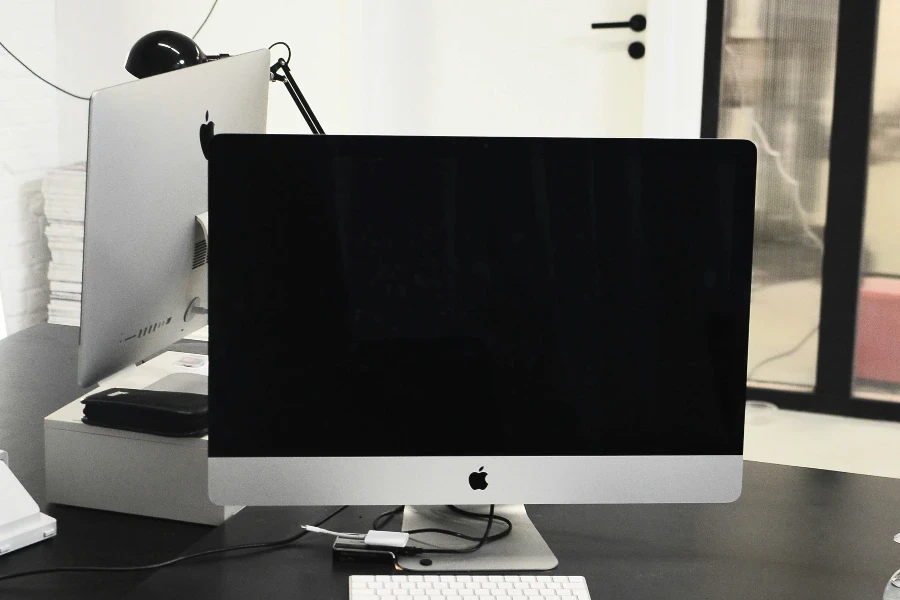The All-In-One PC market is booming, with global revenues soaring to USD 15 billion in 2023. As we look to 2025, the demand for compact, efficient computing solutions continues to rise, driven by technological advancements and digital transformation. This article provides crucial insights for business buyers, including wholesalers and retailers, on selecting the best All-In-One PCs to meet market demands and enhance profitability.
Table of Contents:
– All-In-One PCs: A Comprehensive Market Overview
– In-Depth Analysis of All-In-One PC Market Dynamics
– Key Trends and Strategies in the All-In-One PC Market
– Key Considerations for Selecting All-In-One PCs
– Enhancing Workspaces with All-In-One PCs
– Future Trends in All-In-One PC Technology
– Wrapping Up
All-In-One PCs: A Comprehensive Market Overview

The All-In-One PC market is witnessing significant growth, fueled by the demand for space-saving computing solutions. In 2023, global revenue for Desktop PCs, including All-In-One models, is projected to reach about USD 15 billion. This market is expected to grow at a CAGR of 6.0 % from 2024 to 2032, reaching USD 25.34 billion by 2032. China is anticipated to lead, underscoring the region’s substantial influence and consumer base.
All-In-One PCs integrate the monitor and computing components into a single unit, offering a streamlined design that appeals to both individual and business users. Their minimalistic design and ease of setup make them a preferred choice for home offices and educational institutions. The ability of All-In-One PCs to integrate with various digital ecosystems and applications enhances their appeal, especially in highly digitalized regions like Asia-Pacific and North America.
The competitive landscape is dominated by key players such as Lenovo and HP, which hold significant market shares. Lenovo leads with a 25% share, followed by HP at 22%, showcasing their strong presence and brand recognition globally. These companies continue to innovate, incorporating advanced features like touchscreens and powerful processors to meet evolving consumer demands and maintain their competitive edge.
In-Depth Analysis of All-In-One PC Market Dynamics

The All-In-One PC market is defined by several performance benchmarks and market dynamics. Key benchmarks include processing power, display quality, and storage capacity, with many models now featuring high-resolution displays and SSD storage for faster data access. Market share dynamics are influenced by brand reputation, innovative design, and competitive pricing, with Lenovo and HP maintaining dominance through strategic product placements and marketing.
Economic factors, such as the shift towards remote work and digital learning, have significantly impacted consumer behavior, boosting demand for versatile computing solutions like All-In-One PCs. Seasonal demand often peaks during back-to-school and holiday sales, when consumers are more likely to invest in new technology. Distribution channels have evolved, with online sales platforms gaining prominence, allowing manufacturers to reach a broader audience efficiently.
Recent innovations include the integration of AI capabilities and enhanced connectivity options, catering to the need for seamless digital experiences. These advancements provide consumers with devices capable of handling complex tasks and connecting effortlessly with other smart devices. The product lifecycle is also crucial, with a focus on sustainability and eco-friendly designs to comply with environmental regulations and appeal to environmentally conscious consumers.
Key Trends and Strategies in the All-In-One PC Market

The trend towards mobile and flexible computing devices continues to shape the All-In-One PC market. This is particularly evident in home office setups, where All-In-One PCs offer a compact yet powerful solution. Companies focus on differentiating their products through unique design elements, superior technical specifications, and competitive pricing to capture niche markets, such as gaming or professional use.
Environmental regulations are becoming more stringent, prompting manufacturers to adopt sustainable practices. This includes using recycled materials and designing energy-efficient components, aligning with global sustainability goals and reducing the carbon footprint. In terms of brand positioning, companies like Lenovo and HP emphasize innovation and reliability, leveraging their established reputations to maintain market leadership.
Customer needs for powerful computing solutions without compromising on space or design are addressed through continuous product development and enhancements. By focusing on user-centric designs and incorporating cutting-edge technology, manufacturers aim to deliver products that meet and exceed consumer expectations, ensuring sustained growth and customer loyalty in the All-In-One PC market.
Key Considerations for Selecting All-In-One PCs

When selecting an All-In-One (AIO) PC, it’s important to consider several factors to ensure the device aligns with your business needs and enhances productivity. Here are the key points to consider:
Performance Specifications
The performance of an AIO PC depends on its processor, RAM, and storage. High-performance models often include Intel Core i7 or AMD Ryzen 7 processors, suitable for demanding tasks like video editing or 3D rendering. At least 16GB of RAM is recommended for effective multitasking. Solid State Drives (SSDs) are preferred over Hard Disk Drives (HDDs) due to their speed and reliability, with 512GB being a common choice for business use.
Graphics capabilities are also crucial. Integrated graphics are adequate for general office work, but dedicated graphics cards such as NVIDIA GeForce or AMD Radeon are recommended for graphic-intensive tasks. These components ensure smooth handling of graphic design, video editing, and gaming applications.
Display Quality and Size
The display is a key feature of AIO PCs, combining the monitor with the computer. Sizes typically range from 21 to 27 inches, with 24 inches being popular for balancing desk space and visibility. Full HD (1920×1080) is the minimum resolution standard, but 4K displays offer superior detail and clarity, beneficial for design and media production.
Touchscreen capability can enhance user interaction, especially in collaborative or creative settings. IPS panels are recommended for their excellent color accuracy and wide viewing angles, essential for design work and presentations.
Design and Build Quality
The design and build quality of an AIO PC should match your business environment and durability needs. Premium models often feature aluminum or high-grade plastic casings, offering a sleek appearance and robust build. Ergonomic features like adjustable stands or VESA mount compatibility can improve user comfort and workspace flexibility.
Consider the system’s cooling technology, as efficient thermal management extends component lifespan and maintains performance. Quiet operation is also desirable, particularly in office settings where noise can be distracting.
Connectivity and Compatibility
An AIO PC should offer a range of connectivity options to support various peripherals and network needs. Look for multiple USB ports, including USB-C, HDMI outputs for additional monitors, and Ethernet ports for stable internet connections. Wireless connectivity should include Wi-Fi 6 for faster speeds and Bluetooth 5.0 for seamless peripheral connections.
Ensure compatibility with existing systems and software. The AIO PC should support your current operating systems and applications and integrate smoothly with devices like printers, scanners, and external storage.
Price and Warranty
Price is a key factor, with AIO PCs ranging from budget-friendly options under $500 to high-end models over $2000. Balance cost with performance needs to ensure value without overspending on unnecessary features. Business buyers should consider bulk purchase discounts or leasing options for equipping an entire office.
Warranty and after-sales service are vital for long-term reliability. A standard warranty is typically one year, but extended warranties are available and recommended for business use. Comprehensive support services, including onsite repair and dedicated customer service, can minimize downtime and maintain productivity.
Enhancing Workspaces with All-In-One PCs

Space Efficiency and Aesthetics
All-In-One PCs are known for their space-saving design, integrating the computer and monitor into a single unit. This is beneficial for businesses with limited desk space or open-plan offices where reducing clutter is crucial. The streamlined design enhances the workspace’s visual appeal and facilitates easier office cleaning and maintenance.
Versatility in Business Applications
The versatility of AIO PCs makes them suitable for various business applications. From front-desk operations needing basic computing to creative departments requiring high-resolution displays, AIO PCs cater to diverse needs. Their compact form and wireless connectivity options also suit dynamic work environments where mobility and flexibility are important.
Sustainable and Energy-Efficient Solutions
Modern AIO PCs are designed with sustainability in mind, often featuring energy-efficient components that reduce power consumption and environmental impact. Many models are ENERGY STAR certified, ensuring compliance with international energy standards. This supports corporate sustainability initiatives and reduces operational costs through lower electricity bills.
Future Trends in All-In-One PC Technology

Integration of AI and Voice Assistants
AI and voice assistant integration in AIO PCs is set to transform user interaction. These features enhance productivity by automating routine tasks, providing intelligent recommendations, and enabling hands-free operation. As AI technology advances, expect more intuitive and personalized user experiences in business settings.
Enhanced Security Features
Security is a top priority for businesses, and future AIO PCs will likely include advanced features such as biometric authentication, encrypted storage, and AI-driven threat detection systems. These enhancements protect sensitive data and ensure compliance with industry regulations, reducing cyber threat risks.
Advanced Display Technologies
The evolution of display technology will continue to enhance AIO PCs’ visual capabilities. Expect increased adoption of OLED and mini-LED displays, offering superior color accuracy and contrast ratios. These advancements will benefit creative professionals and industries where visual precision is crucial.
Wrapping Up
In summary, when choosing an All-In-One PC, consider performance specifications, display quality, design and build, connectivity, price, and warranty. AIO PCs offer space efficiency, versatility, and sustainability, making them a valuable asset for modern business environments. Keep an eye on future trends like AI integration, enhanced security, and advanced display technologies to stay ahead in the evolving tech landscape.



